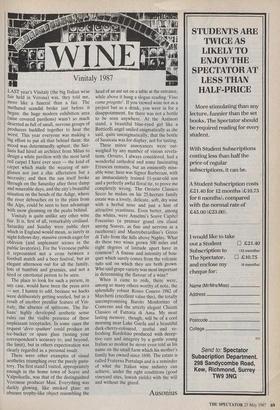'`i 4 ; Era ; . '11 i
Vinitaly 1987
LAST year's Vinitaly (the big Italian wine fair held in Verona) was, they told me, more like a funeral than a fair. The methanol scandal broke just before it began: the huge modern exhibition area (nine covered pavilions) wasn't so much deserted as full of small, nervous groups of producers huddled together to hear the worst. This year everyone was making a big effort to put all that behind them: the mood was determinedly upbeat; the Sici- bans had hired an architect from Milan to design a white pavilion with the most lurid red carpet I have ever seen — the kind of carpet which made the wearing of sun- glasses not just a chic affectation but a necessity; and then the sun itself broke through on the Saturday after three damp and miserable days, and the city's beautiful situation on the bends of the Adige, where the river debouches on to the plain from the Alps, could be seen to best advantage with snow gleaming on the peaks behind. Vinitaly is quite unlike any other wine fair. It is, first of all, remarkably civilised. Saturday and Sunday were public days which in England would mean, as surely as night follows day, massive crowds eager for oblivion (and unpleasant scenes in the public lavatories). For the Veronese public it represented not a cross between a football match and a beer festival, but an elegant afternoon out for all the family, lots of bambini and grannies, and not a tired or emotional person to be seen.
The place to look for such a person, in any case, would have been the press area — not, I hasten to add, because we hacks were deliberately getting sozzled, but as a result of another peculiar feature of Vin- italy, the absence of spittoons. The Ita- lians' highly developed aesthetic sense rules out the visible presence of these unpleasant receptacles. In some cases the request 'dew) sputtare' could produce an ice-bucket or spare glass (testing your correspondent's accuracy to, and beyond, the limit), but in others expectoration was clearly regarded as a personal insult.
There were other examples of visual aesthetics triumphing over the purely gusta- tory. The first stand I visited, appropriately enough in the home town of Soave and Valpolicella, was that of the distinguished Veronese producer Masi. Everything was darkly glowing, like smoked glass: an obscure trophy-like object resembling the head of an ant sat on a table at the entrance, while above it hung a slogan reading 'Vino come progetto'. If you viewed wine not as a project but as a drink, you were in for a disappointment, for there was not a bottle to be seen anywhere. At the Antinori stand, a beautiful blue-eyed girl like • a Botticelli angel smiled enigmatically as she said, quite unenigmatically, that the bottle of Sassicaia was for display, not for tasting.
These minor annoyances were out- weighed by any number of vinous. revela- tions. Orvieto, I always considered, had a wonderful cathedral and some fascinating Etruscan remains, but an eminently miss- able wine: here was Signor Barberani, with an immaculately trained 11-year-old son and a perfectly awful floral tie, to prove me completely wrong. The Orvieto Classico Secco he makes on his 25:hectare family estate was a lovely, delicate, soft, dry wine with a herbal nose and just a hint of attractive yeastiness. Even better, among the whites, were Anselmi's Soave Capitel Foscarino (a premier grand cru classe among Soaves, as fine and nervous . as a racehorse) and Mastroberardino's Greco di Tufo from the hills above Naples. What do these two wines grown 500 miles and eight degrees of latitude apart have in common? A finesse and intensity of bou- quet which surely comes from the volcanic tufo soil on which they are both grown. Who said grape variety was most important in determining the flavour of a wine?
When it came to reds, there were, among so many others worthy of note., the splendidly robust Rosso Conero 1982 of Marchetti (excellent value this), the totally uncompromising Barolo Monfortino of Conterno and the utterly elegant Chianti Classico of Fattoria di Ama. My most lasting memory, though, will be of a cool morning near Lake Garda and a beautiful dark-cherry-coloured, zestful and re- freshing Bardolino produced with decep- tive care and integrity by a gentle young Italian so modest he never even told us his name on the small farm which his mother's family has owned since 1690. The estate is called Fraterna Portalupi and is a reminder of what the Italian wine industry can achieve, under the right conditions (good vineyard sites, lowish yields) with the will and without the greed.
Ausonius









































































 Previous page
Previous page